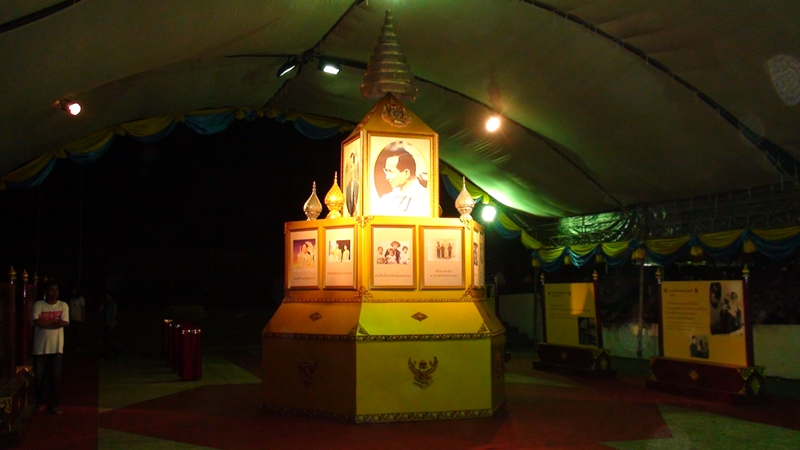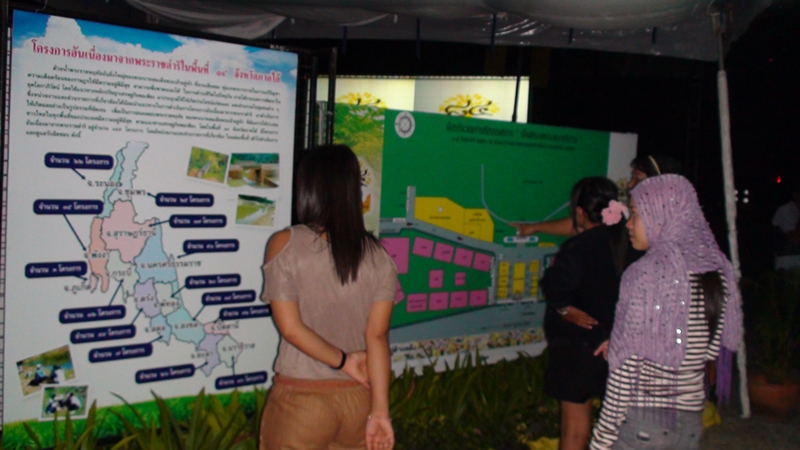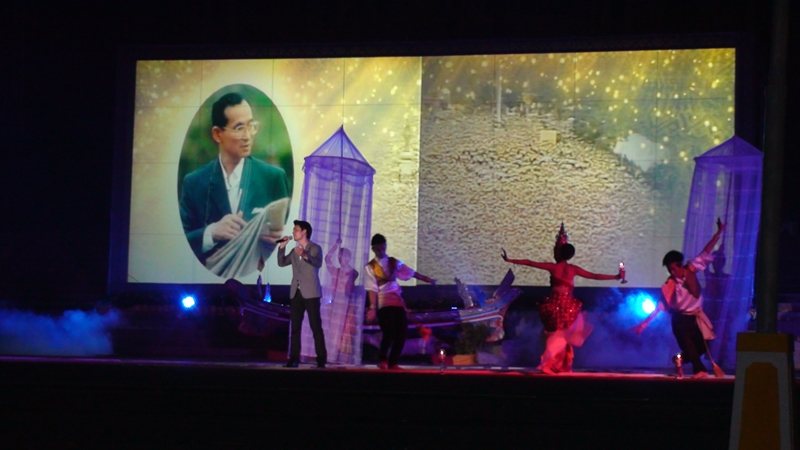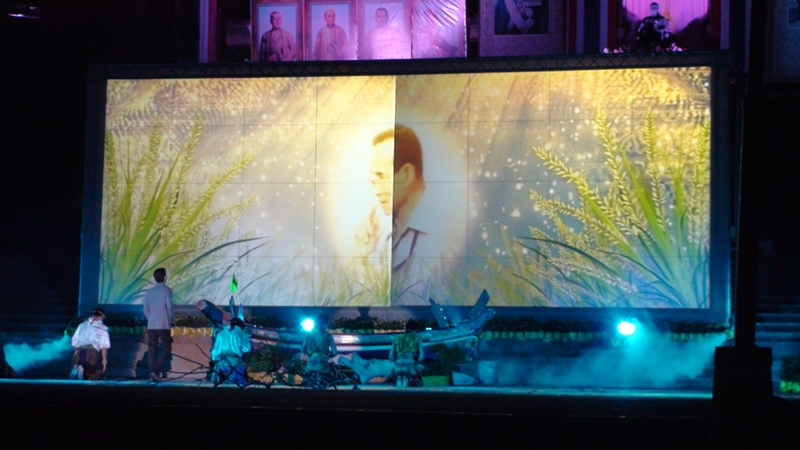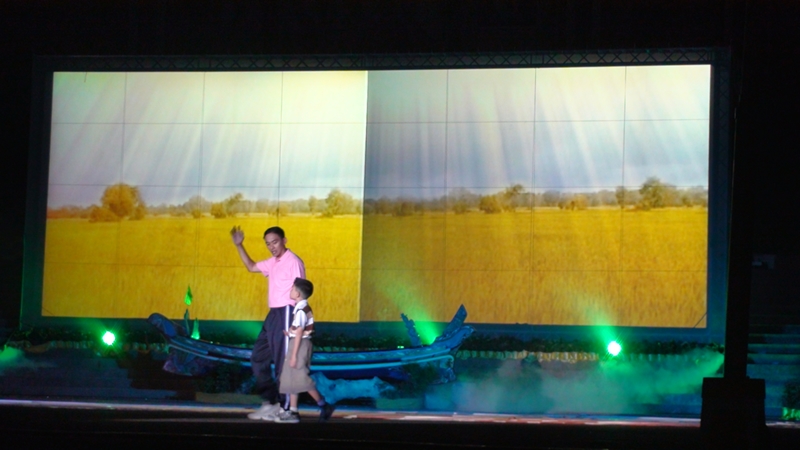The large outdoor video screen shows a young boy sitting at his desk in a Thai rural schoolroom. The desk is an old wooden stall of 1950s vintage, and the classroom’s walls are painted wood panels. The boy gazes into the air, visualizing all the manifold activities and achievements of his king – from water filtration and rain-making inventions to photography and painting. Sweet music accompanies these reflections. Inspired by these musings, he eagerly raises his hand and asks his teacher “Teacher, our king has undertaken so many projects. For whom does he do this?” The female teacher is clad in a fawn civil service uniform with obligatory service ribbons – an anachronistic teachers’ working garb that matches the physical setting. She replies in a sweet motherly tone: “That’s a good question. I will give you some homework. Tomorrow, tell the class for whom His Majesty does these marvellous things, and from where he gets his inspiration.” As the boy walks home he asks himself, “Who is it that gives our king this inspiration.” He thinks of “auntie and grandma, people in the countryside and the city, members of our family, our neighbourhood, and all the people of Thailand.” He passes a shop window with a television screening an old clip of the king trailed by an entourage visiting one of his projects. Then it dawns on him – “I’ve got it – the source of our king’s inspiration is everywhere that Thai people live – Thai people everywhere.” As his childish voice intones this profound truth, a crescendo of symphonic music builds. The screen shows Thai citizens gazing into the sky, some standing at attention, including a shot of a group of smiling Muslim men and women with a Thai national flag flowing behind them. The Thai Buddhists apparently needed no flag. The boy reverently wais to the royal images broadcast on the TV in the shop. The screen now fills with a portrait of the king, dressed in royal robes with palm upheld, and the effusion of loyalty concludes. This media clip is one of a host of expressions of fealty that have been produced to mark the year of King Bhumphol’s 84th birthday. The king’s birthday falls on 5 December, but in keeping with a long-standing pattern, officially-promoted commemorations have been planned since January to run through the whole year. The clip described here is sponsored by the Prime Minister’s Office and the Ministry of Commerce and has been broadcast this year for a few months already on state-run television Channel 11. On this occasion, it was projected onto a large outdoor screen as a prelude to a sound-and-light show organized by the Internal Security Operations Command of the Fourth Army region (ISOC 4), responsible for Thailand’s southern provinces.
The venue for this military–sponsored event was a section of the municipal park of Hat Yai City, southern Thailand’s business metropolis. It was staged on the evening of 6 June, the half-way point of a twelve day event to exhibit products of royal development projects in the region– or such at least was its ostensible purpose according to the cumbersome official title: “The Exhibition of projects on the Royal Initiative in the 14 southern provinces to commemorate the occasion of His Majesty’s 84th birthday on 5 December 2554 and his 7th cycle.” In fact, however, the exhibits of products of the royal projects, largely village crafts, were dwarfed by installations extolling the royal family and its engagement in development projects generally, including Princess Ubol Ratana and her television program “To Be Number One.” Visually, the highlight of the exhibits was a golden stupa-shaped construction with portraits of the king, surrounded by golden panels describing the king’s initiatives. They were also partly translated into English. The introductory clip also featured English sub-titles, unlike its local televised version. This suggests that the army expected that Hat Yai’s revived tourism industry would bring Malaysians and Singaporeans to visit and admire the exhibition. That evening, at least, tourists were nowhere to be seen at the event venue, though they were crowding the city’s shopping areas.
The portrayal of the dutiful loyal schoolboy was only a mild prelude to what followed in the evening’s spectacle of loyalty. Soldiers in various states of dress and semi-dress shuffled the hundred-or-so meandering Thai visitors towards the main stage set up under the park’s statue of the seated King Chulalongkorn. Above and behind the statue were arrayed pictures of the nine kings of the Chakkri dynasty illuminated with spotlights. Twin pictures of King Bhumibol in a gesture of blessing were projected against two huge screens. Yellow light suffused the stage beneath, which was being steadily flooded with clouds of dry-ice. Fountains of yellow sparks shot out of cylinders flanking the stage. The audience stood reverently as the king’s royal anthem boomed out, and then the show began.
The screen momentarily dissolved into darkness, to be followed by a burst of stars and orchestral string music. A sepia-coloured old map of Siam emerged, highlighting the peninsula region. Ironically it was an English map. A velvety male voice intoned:
The father’s children (luk khong pho) – our Thailand – have proceeded well in every way, and that is because there is something important in our hearts always, in everyone throughout the country: that is, we have Prachao Phaendin with the highest virtue since the past until the present. The loving children of Father are proud that we are under the protection of the royal shade. [phraboromaphotisompharn]
This was the cue for young dancers to run onto the stage bearing aloft white cotton ceremonial banners. Out of one of these cylindrical banners emerged a nattily dressed male with a microphone; it was none other than Lieutenant-Colonel Wanchana Sawasdee, famous for his acting role as King Naresuan in the three-part nationalist film epic. He launched into a solemn song of praise for the wisdom of King Bhumibol, the source of moral strength for all Thais. Photographs of the king and his activities during his long reign slid across the screens behind the singer. This performance, its images and message, were not particularly distinctive in the context of previous events around the country praising the king’s virtues and sacrifices. Further, the song’s lyrics echoed the habitual calls for national unity (samakki) on the basis of common reverence to the monarch and as recompense for his sacrifices.
The performance that followed, however, moved beyond this to equate the king with the character of a deity. It began with the sound of falling rain, followed by a film of thunder clouds illuminated from behind by the rays of the sun. Over this portrait, with obligatory orchestral music, came a young boy’s voice: “Father, what causes the rain to fall and why does it drop from the sky?” A paternal voice answers: “in the sky there are many deities, my child, and in heaven there are also an uncountable number of deities. Oh, and there is one deity who is with us on this land of Thailand. His rain helps us in difficult times that we face when we are lacking water ” The son then asks, “Can we see this deity father?” “Yes”, the fatherly voice replies, “you can see him there.” At this point, King Bhumibol’s portrait appears in an opening between the clouds, framed by ripe rice stalks. Whereupon the singer again breaks forth extolling the king and his bringing of water to the land, while the film screen shows scenes of happy villagers in their rice fields looking up into the sky. The song ends with the screens showing a vast expanse of ripening rice fields. Onto the stage walks a man in track pants and a young boy, who asks: “Father, isn’t His Majesty tired from bringing us so much water?” The father answers: “Listen to me well…remember that His Majesty is the father of all Thai people, he is prepared to sacrifice all things for the happiness of his children. Because of this we need to create goodness for him.”
Celebrational statements and images concerning King Bhumibol run the spectrum from earthly humanity to ethereal divinity. This is abundantly clear in televised presentations this year, ranging from his portrayal as a loving father to his people, “a good person”, an ideal of virtue, and in this case, a deity. The image of a weary and hard-working sovereign is effectively captured in one program aired on “dl TV” cable station. Filmed in semi-realist mode and well acted, it features a Chinese grandmother in Bangkok’s Sampeng district learning the words to the royal anthem which she plays on an old gramophone record. Her young grandson jumps earnestly to attention every time he hears the recording. He is concerned about the drop of sweat shown on the monarch’s nose in a framed portrait hanging on the wall. The theme of the short film centres on the hard work and weariness of King Bhumipol on behalf of his people, symbolized by the drop of perspiration. The trend towards sacralisation of the king has been discussed by a number of authors in the recent collection Saying the Unsayable (edited by Soren Ivarsson and Lotte Isager, NIAS Press, 2010). Among them, Peter Jackson has highlighted the ambiguity of the identity of the country’s “guardian angels” referred to in various texts over the past decade, particular in 2006, the year of the coup. Sarun Krittikarn nicely discusses tele-visual representations of the monarch in connection with the bringing of rain, observing that the monarch tends to be “invisible” in portrayals because he is transmuted into a symbolic avatar. In the Hat Yai presentation of grateful villagers gazing at the rain and the sky, the king was both immanent and transcendent. The verbal commentary behind the water-centred performance in Hat Yai did not simply articulate a quaint comparison between the monarch and deities – it was a declaration of equivalence. Though, given the destructive flooding this year in the south, water may have been an unfortunate image. Nonetheless, of all the available representations of King Bhumibol to choose from, the Fourth army’s event managers had sided with the angels.
The army’s sponsorship of this spectacle of reverence in Hat Yai might be viewed as quite unremarkable at a time when many state agencies are launching commemorative celebrations for the king’s 84th year and engaging in the customary competition for ritual prominence. However, the event is worthy of comment because it reflects not only a deliberate army policy on an ideological level, but also a particular imperative to resuscitate ISOC 4’s image in the south. In January the army announced that it was promoting eight key activities to mark the king’s 84th birthday. The objective was to publicise the king’s work and to urge all people “to sacrifice their own private gains and reconcile for the sake of the monarchy. By holding on to the institution, the people will be united once again.” Since the army-led coup of 2006, the cry of “the monarchy in danger” has provided the key ideological buttress for the army. Various “exhibits” were designated as one of the activities for 2011. The Hat Yai spectacle can be viewed as significant in the more specific context of the crisis in public relations facing the army in the fourth region, particularly concerning its performance in the violence-riven border provinces. To be sure, the Hat Yai event was not specifically directed to the problems in the border provinces, but nonetheless can be read as an effort to align the army with the royal force of virtue in the cause of affirming the unity of all Thais under the king. Products from the Muslim-majority border provinces were featured in the exhibits, and the violence was explicitly referred to as a matter of concern for all Thais by the female announcer at the conclusion of the show. Most significantly, the Hat Yai event was planned by Lt-Gen. (formerly Colonel) Akkara Thipoj, and marks his return to the post of ISOC Region 4 spokesman, a position which he had previously held from 2006 to 2008.
Akkara Thiproj is a hard-hitting pro-active publicist for the army in the border provinces. He was first appointed as ISOC Region 4 spokesman in 2006, when insurgent violence began to peak. He signalled his aggressive stance soon after his appointment by stating that “this is a war of information, and whoever wins that war will prevail.” From that time, he became a thorn in the side of independent-minded Thai journalists, corralling them in press conferences and giving up-beat interpretations to setbacks in security operations. He enthusiastically wheeled out tame captive insurgents for the press to interview. Even the journalists from army-run TV, Channel 5, were disgruntled by his gung-ho approach. Akkara’s departure from ISOC Region 4 after the arrival of the new ISOC commander General Pichet Wisaijorn in late 2008 marked a change in army public relations n the south. The vacuum that emerged was not immediately evident because General Pichet embarked on his own publicity efforts, focusing on his new demonstration farm for the “Sufficiency Economy” opposite the main army base at Fort Sirinthorn. Pichet’s message was that development projects and the training of villagers under the royal principles of the sufficiency economy – exemplified in fish-rearing and the production of organic fertilizer – would bear fruit in loyal Muslim citizens who trusted the state. In the face of continued insurgent violence, local and foreign journalists became bored with Pichet’s development = patriotism formula.
Pichet’s performances eclipsed the function of Akkara’s replacement. A highly educated, but shy man, this new officer spent his time trailing delegations of visiting foreign dignitaries and rights activists (such as Angkhana Nilapaichit) around the border provinces. To journalists, he seemed intent on avoiding them. Some began to wish that Akkara was back – at least he had answered their phone calls. Crisis management was neither the forte of Pichet nor his quiet and sequestered spokesman. The litmus test came with the controversial mass shooting of worshippers at a Mosque in Ai Bai Yae village in Narathiwat in mid-2009. The army was unable to cope with the mass of reporters questing for answers about the culprits. Instead, the Democrat government’s heavyweight Suthep Thuaksuban took on the job of parrying awkward questions and speculations.
By the time Lt Gen Udomchai Thammasarojrat replaced Pichet in late 2010 as 4thRegion ISOC commander, the army in the south was not in a happy state. Purloining the army’s own sacred counter-insurgency mantra of “Politics Leading the Military”, the Democrat led-government had pushed through legislation creating an independent civilian-led Southern Border Provinces Administrative Centre, freeing SBPAC from its previous budgetary dependency on the army. ISOC 4’s budget for development projects reportedly plummeted by 100 million baht as the lion’s share of the “development” role in the border provinces was shifted to the newly empowered SBPAC earlier this year. But even on its own specialist turf of security operations the army was found wanting. In January 2011, just two days after a lavish ceremony in Maelarn District of Pattani Province where the Prime Minister pronounced the lifting of the Emergency Decree in that district – the first in the three provinces –, an ill-prepared army base in Rangae District of Narathiwat province was overwhelmed by insurgents; four soldiers were killed (including the commander and senior NCO) and over 60 weapons taken, together with thousands of rounds of ammunition. This was embarrassing for the Abhisit government, but more so for General Udomchai. Instead of coming clean and admitting faults in local-level command, Udomchai’s hapless army spokesman (a new appointee) retreated into defensiveness. Journalists were denied entry into the army camp to photograph the results of the attack. Four Muslim conscripts were taken into custody for questioning on suspicion of having provided key information to insurgents prior to the attack, though this fact was withheld from reporters. Two months later, six soldiers of the same army battalion manning an outpost were attacked, the sergeant wounded, and all their weapons stolen by the assailants. In a fit of frustration, Udomchai categorically forbad his subordinates to speak to journalists, stolidly announcing that an investigation into the incident would be mounted. Though news reporters were rightly critical of the army in the light of these successful insurgent attacks, they missed the significant fact that the beleaguered army Task Force in question (Task Force 38) was a battalion of the new 15th Division. This formation was touted as a new initiative for providing a locally-raised unit to eventually take over security duties from the existing forces in the three provinces, which are drawn from all the military regions. It was not a good advertisement for the new force, which was supposed to reach full strength by October. General Udomchai had reached the end of his tether in dealing with the press virtually alone. After the first attack, rumours began circulating among journalists that General Akkara would return to the south to take up a public relations advisory position to Udomchai. By May, he was back in the saddle as the official ISOC 4 spokesman.
Shortly after organizing the royal spectacle at Hat Yai in early June, Akkara was involved in the organization of a tour for Bangkok –based Thai journalists. Though this Cook’s tour of the south was initiated from army central headquarters, the itinerary bore the stamp of Akkara’s style in corralling news reporters. The first activity was a visit to the 15th Division opposite the army’s Fort Ingkayut in Pattani. There the journalists were shown a video describing the achievements of the army in the border provinces and given a presentation on the new 15th Division and its future role, after which they were shown around the camp. The next day the journalists were divided into groups, with activities involving visits to the SBPAC (to be informed of development programs) the Southern Police Bureau (to be informed of progress in cases of investigation), and the army’s “Peace-building Centre” (an innocent name for its main interrogation centre), to learn about insurgent recruitment. Another group was taken to visit army-run development projects, admire mosques and visit communities which were exemplary cases of harmonious relations between Buddhists and Muslims. On the final day, the group was taken to Songkhla Province to learn of the army’s application of the “re-training” component of the Internal Security Act there, finishing with a visit to an army camp where former insurgents and sympathizers were undergoing re-education in a program titled “Joining Together to do Good for the Country.” After a further hours shopping in Hat Yai, the group flew back to Bangkok.
The lack of news media reports based on this tour in the following weeks suggest that it did not inspire any startling scoops from the journalists. The only TV report that emerged in later weeks, on Channel 3, attests to the success of the army’s agenda in choreographing one-dimensional news. This 5-minute news story focused on the new 15th Division, and the Channel 3 journalists swallowed the army’s line without demur. As if reading from the army’s own script, the anchorman of Channel 3’s “Three Dimensions” program introduced the clip with the formula line: “The first in efforts to solve the problems permanently in the three southern border provinces is to establish military units with responsibility for the region, for which the 15th Division has been organized and has now reached 85 per cent of its strength.” The clip followed along the same lines, showing aerial shots of the division’s administrative buildings and barracks while intoning that the division’s conscripts and NCOs were drawn primarily from the border provinces. The First, Second, and Third army regions’ troops would at some undefined time in the future be withdrawn and this division would take over. Not much of this information was new, and though the idea that the borderland would once again return to the control of the Fourth Army with its “local” soldiers sounded attractive, none of the key challenges facing the army were explored in this passive report. The “eighty-five per cent” strength of the new division was a figure that masked the fact that only five of its planned nine battalions were operational, and that there was a serious shortage of NCOs and platoon level officers. Nor was it observed that there was a severe discrepancy between the meager strength of this infantry division – a little over 7,500 – and the current deployment of 30,000 soldiers, marines and volunteer rangers in the three provinces. In fact, the 15th division will be incapable of managing the security task alone, and will need to be bolstered by at least 6 regiments of rangers. A thirty-minute chat with a friendly army officer over a bottle of Regency brandy would have yielded a journalist more instructive information on the 15th Division than this three- day guided tour. Nonetheless, the positive spin was needed by the army, and the journalists had returned the favor of free hotel accommodation, food and sight-seeing.
The first six months of 2011 has been a time of decidedly mixed fortunes both for the army and government in the country’s turbulent south. In statistical terms there seems to have been an overall drop in the average number of violent incidents over the first five months of this year compared to last year, though insurgent attacks on security forces and an irregular, though persistent, spate of spectacular bombings continues to highlight insurgents’ potency. Police enumerate 413 violent events to the end of May (last year’s total for twelve months was 1,165). Police figures present the trend of events in terms of a daily average, with 3.19 per day occurring in 2010 compared to 2.73 over five months to the end of May this year. But this decimalized analysis of trends does not express public perceptions of the violence, either in the south, or elsewhere in the country. During a closed-door meeting with ISOC 4 officers in late May, General Udomchai is reported to have explicitly warned them not to use the expression “things are improving” in public, but rather “we continue to carry out our security duties.” It was a pre-emptive measure against possible future embarrassment in a long war with a secretive, unpredictable and persistent opponent. As part of this war, Akkara Thiproj and the army clearly see the provision of public relations spectacles as a necessary weapon, though others might view them as a thin substitute for decisive performance on the ground.
 Facebook
Facebook  Twitter
Twitter  Soundcloud
Soundcloud  Youtube
Youtube  Rss
Rss 